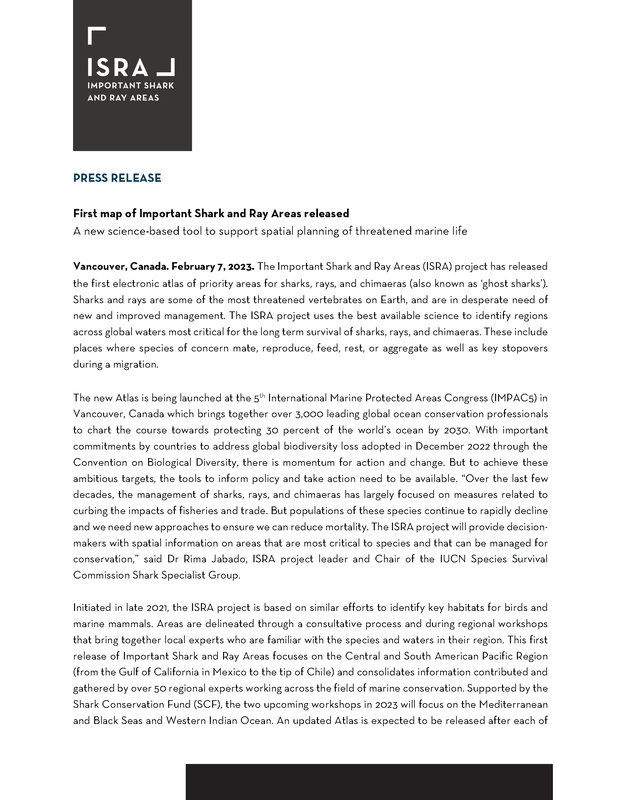|
«A new science-based tool to support spatial planning of threatened marine life» PRESS RELEASE | Vancouver, Canada. February 7, 2023.
The new Atlas is being launched at the 5th International Marine Protected Areas Congress (IMPAC5) in Vancouver, Canada which brings together over 3,000 leading global ocean conservation professionals
to chart the course towards protecting 30 percent of the world’s ocean by 2030. With important commitments by countries to address global biodiversity loss adopted in December 2022 through the Convention on Biological Diversity, there is momentum for action and change. But to achieve these ambitious targets, the tools to inform policy and take action need to be available. “Over the last few decades, the management of sharks, rays, and chimaeras has largely focused on measures related to curbing the impacts of fisheries and trade. But populations of these species continue to rapidly decline and we need new approaches to ensure we can reduce mortality. The ISRA project will provide decisionmakers with spatial information on areas that are most critical to species and that can be managed for conservation,” said Dr Rima Jabado, ISRA project leader and Chair of the IUCN Species Survival Commission Shark Specialist Group. Initiated in late 2021, the ISRA project is based on similar efforts to identify key habitats for birds and marine mammals. Areas are delineated through a consultative process and during regional workshops that bring together local experts who are familiar with the species and waters in their region. This first release of Important Shark and Ray Areas focuses on the Central and South American Pacific Region (from the Gulf of California in Mexico to the tip of Chile) and consolidates information contributed and gathered by over 50 regional experts working across the field of marine conservation. Supported by the Shark Conservation Fund (SCF), the two upcoming workshops in 2023 will focus on the Mediterranean and Black Seas and Western Indian Ocean. An updated Atlas is expected to be released after each of these meetings to ensure the most updated data are available online. Geographic information System (GIS) layers for each area will be made freely available for scientists, managers, conservationists, or the interested public upon request, or anyone can view these areas on the ISRA electronic atlas available at https://sharkrayareas.org/e-atlas/. Users can also filter areas to view them based on the ISRA Criteria or by region, country, species, and depth. “As areas are added to the Atlas from around the world, it will become the most comprehensive and authoritative tool to identify areas most critical for the survival of sharks, rays, and chimaeras,” added Dr Jabado. Some ISRAs from the first release include areas such as the Cocos-Galápagos Swimway, a migratory corridor that connects important habitats between Costa Rica and Ecuador for at least seven threatened species including the Whale Shark (Rhincodon typus), Scalloped Hammerhead (Sphyrna lewini), and Pelagic Thresher Shark (Alopias pelagicus); the Costa Rica Thermal Dome, a dynamic oceanographic feature where Spinetail Devil Rays (Mobula mobular) feed and where Silky Sharks (Carcharhinus falciformis) form large aggregations; and the Gulf of Montijo in Panama where contemporary records of Largetooth Sawfish (Pristis pristis) indicate that the area is being used for reproductive purposes making it a regionally, if not globally, significant location. Now that these important areas have been identified, they can be prioritized for the protections they need. “As governments seek to implement their 30x30 obligations and develop impactful marine protected areas, SCF is pleased to support this work and plans to use it to guide its new Shark Biodiversity Initiative which is designed to enhance biodiversity by protecting the most biologically important areas for sharks and rays.” said Lee Crockett, Executive Director for the Shark Conservation Fund. The ISRA project is also contributing to a suite of tools that have been developed to identify critical habitats for species. “As we continue working on identifying ISRAs in parallel with our work to delineate Important Marine Mammal Areas (IMMAs), I look forward to seeing these maps side by side because that’s when we will start seeing real conservation priorities and inform spatial management”, added Prof. Giuseppe Notarbartolo di Sciara, co-Chair of the IUCN Marine Mammal Protected Areas Taskforce. The ultimate goal of these area-based approaches is to ensure that decision-makers have the right information to conserve species in an era of rapid biodiversity loss. For the first time, this will now be possible for sharks, rays, and chimaeras. Comments are closed.
|


 RSS Feed
RSS Feed